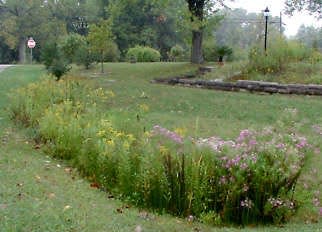Rain gardens can help divert water from basements and storm drains. Here's how they work.
Carefully designed rain gardens can help funnel water to a designated area and keep it out of our basements and storm drains.
Hardscapes like driveways and sidewalks move water into storm drains rapidly, taking chemicals from roof shingles and roadways with it. Funneling runoff into gardens can help the water soak into the soil, where the plants can use and clean it.
Selecting a location for your rain garden is a critical step. The garden should be at least 10 feet from your home or other structures to ensure water is diverted from, not directed to, your home.
Look for a natural depression or an area at the bottom of a slope. Pay attention to where water runs off your sidewalks and driveways, and look for ways to divert that water into a garden.
Once you have a location selected, test the infiltration rate of the soil. Dig a hole at least 18 inches deep and 12 inches wide using a shovel or post-hole digger. Using a trowel, rough the sides of the hole where your shovel smoothed the soil. Place a yard stick in the hole and fill it completely with water.

If the water drains eight inches or more in an hour, you can select from a wide variety of plants. If that rate is closer to two inches in an hour, your soil is likely more clay and you will have fewer options when it comes to plant selection.
In these soils, only use plants that tolerate wet feet. In some extreme cases, where soils are often saturated or flooded, water plants may be used.
After your infiltration test, call before you dig (811) to make sure you will not encounter any wires or pipes during excavation. This is also an excellent time to conduct a soil test to determine any needed amendments.
Adding compost not only helps provide nutrients for plants but also increases the rate in which your soils soak up water. The depth and width of your rain garden depends on your space and your preference.
Generally, a rain garden is somewhere between six and 12 inches lower than the surrounding area. If your yard is flat, you may need to plan to haul some soil away.
To better visualize the area of your garden as you dig, you may want to spray paint an outline or use a hose or rope to draw the shape of the garden. Make sure you have decided where the water will come in and how.
Water may naturally pool in the area of your garden, or you may need to move a drainpipe to funnel water from your roof or driveway.
Just as important as where the water will come in is also how it will come out. The hope for your rain garden is that it holds most of the excess water most of the time, but in a torrential rain, there should be a backup plan.
As you dig your garden, plan for a spot for excessive water to drain away without pooling on your plants.

An important part of a rain garden is a berm bordering the area. This berm can be made of soil and covered in a groundcover or grass. The overflow for your garden should consist of a break in the berm, lined with rock, to allow water to drain away.
Selecting plants for your rain garden is one of the easiest parts. Most native plants make suitable rain garden plants as they can handle both dry and wet conditions. Any plant that does not tolerate wet feet (the tag will indicate this) is not suitable for a rain garden.
As we face the reality of a world with waters contaminated with oils, fertilizers and other chemicals, rain gardens and other simpler gardening practices can greatly reduce the chemicals each of us are sending to our waterways.
Make sure to keep grass clippings off sidewalks and streets, and consider adopting a nearby storm drain that you can keep clean from trash and debris. When it comes to conservation, every little bit helps.
Ariel Whitely-Noll is the horticulture agent for Shawnee County Research and Extension. She can be reached at arielw@ksu.edu.
This article originally appeared on Topeka Capital-Journal: Rain gardens help filter and conserve rainwater. Here's how they work.

